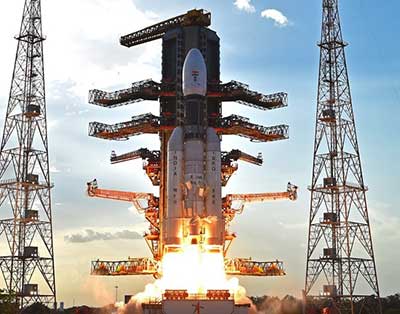Date : 12/07/2023
Relevance – GS Paper 3 – Developments in field of Science and Technology – Space missions
Keywords – Chandrayaan-3, LVM-III, PSLV, ISRO
Context –
ISRO's upcoming mission, Chandrayaan-3, aims to showcase the comprehensive capabilities of safe landing and roving on the lunar surface. The launch is scheduled for July 14 at 2.35 pm aboard the powerful Launch Vehicle Mark III. The mission will consist of a lander and a propulsion module, working in tandem to reach a circular orbit around the Moon.
The Enchanting Moon: Mesmerizing Beauty and Scientific Curiosity Ignite Interest
The allure of the Moon is undeniable. Its captivating presence fascinates not only children and poets but also scientists seeking to unravel its mysteries. India, equipped with a robust industrial and technological support base and a talented pool of human resources, is well-positioned to embark on a close study of the Moon. The Indian Space Research Organisation (ISRO) continues to attract the nation's brightest minds from prestigious institutions, further enhancing its capabilities.
Chandrayaan-1: Paving the Way
ISRO's lunar exploration journey began with Chandrayaan-1 in 2008. The mission, facilitated by the successful Polar Satellite Launch Vehicle, included a lunar orbiter and an impact probe. As the probe descended to the Moon's surface, it gathered crucial data on the chemical composition of the lunar atmosphere. This mission unveiled the presence of water molecules on the Moon, a discovery with significant implications for future crewed missions. Notably, the probe left an indelible mark by carving India's national flag on the lunar surface, symbolizing the country's arrival in space exploration.
Chandrayaan 2: A Missed Opportunity
Building on the successes and lessons learned from Chandrayaan-1, ISRO launched Chandrayaan-2 in 2019. This mission, propelled by the Geosynchronous Satellite Launch Vehicle, aimed to deploy a lander carrying a rover. Unfortunately, a software glitch led to a crash landing of the lander and prevented the rover's detachment, hindering further surface exploration. However, citizen participation in this endeavor proved invaluable when an amateur space enthusiast, Shanmuga Subramanian, identified the debris location, later confirmed by NASA. Such collaborative efforts highlight the potential for engagement and the creation of opportunities in scientific projects.
Chandrayaan 2: A Missed Opportunity:
Presently, ISRO's focus is on Chandrayaan-3, which seeks to demonstrate the complete capability of safe landing and roving on the lunar surface. The mission's launch is set for July 14, and it will be carried by the Launch Vehicle Mark III, also known as GSLV Mk III. The lander, accompanied by a propulsion module, will embark on a journey to a circular orbit around the Moon. Once in position, the lander will descend to the lunar surface, deploying a rover and various scientific equipment. The lander and rover are expected to operate for approximately two weeks, conducting investigations into the chemical composition of the lunar surface, local seismic activity, plasma concentration, and more.
Beyond lunar exploration, Chandrayaan-3 has a broader scope. The propulsion module will carry a payload called 'Spectro-polarimetry of Habitable Planet Earth' (SHAPE), designed to track radiation from Earth. This data will help identify potential signatures of life, assisting future missions in the search for signs of life on habitable exoplanets. Thus, Chandrayaan-3 extends its gaze beyond the Moon, aiming to contribute to our understanding of life's existence beyond our cosmic neighbor.
Importance of Collaborative Missions: Strengthening Scientific Exchange and Global Camaraderie
The significance of missions like Chandrayaan reaches far beyond national boundaries. Collaborative efforts involving multiple countries strengthen scientific exchange and foster camaraderie. The exploration of the Moon's south-polar region presents opportunities for future international collaborations. These areas, shrouded in perpetual shadow, harbor hydrogen, water, ice, and possibly primordial material. Unraveling the mysteries of the largest lunar crater, formed billions of years ago, holds the key to unlocking insights into the origins of the Solar System. By understanding our cosmic neighbor, humanity can gain profound insights into the cosmos.
Rationale Behind R&D in high-tech areas
Investing in high-tech areas like space exploration is not a choice between immediate benefits and public welfare. Developing nations require knowledge of advanced concepts to enhance their citizens' quality of life. Space technologies have become indispensable in weather prediction, marine resource assessment, forest cover estimation, communication, and defense applications. Striking a balance between futuristic advancements and immediate relevance is essential for every country.
R. Chidambaram, a former Principal Scientific Advisor to the Government of India, emphasized that engaging in emerging technologies positions a nation as a leader in the field, providing leverage in international negotiations. This pursuit elevates a country's scientific and technological foundation, contributing to the well-being and prestige of its citizens.
Conclusion
In conclusion, Chandrayaan-3 represents India's ambitious endeavor to explore the Moon while setting its sights on the broader horizon of scientific discovery and international collaboration. The mission, with its advanced objectives and lessons learned from past experiences, will propel us closer to understanding the Moon's secrets and our place in the vast cosmos.
Probable Questions for UPSC Mains Exam
- Chandrayaan-3 aims to demonstrate end-to-end capabilities for safe landing and roving on the lunar surface. Discuss the significance of this mission for India's space exploration endeavors and its potential contributions to scientific advancements. (10 Marks,150 words)
- International collaboration plays a crucial role in lunar exploration missions like Chandrayaan. Analyze the importance of collaborative efforts in strengthening scientific exchange and camaraderie between countries. Also, discuss the potential for future collaborations in exploring the Moon's south-polar region and its significance in unraveling the mysteries of the Solar System's origins. (15 Marks, 250 words)
Source – The Hindu







